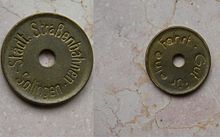Tram coin
A tram coin , also tram money , tram brand , driving brand , driving coin , token , token , change brand , number marker or number coin called, is a special coin , as money substitutes instead of a regular ticket is issued from paper or cardboard. Apart from the eponymous tram , the principle can also be found in numerous other public transport systems. Such tokens are only available in advance sales and are usually only valid for a single journey without changing . They are collected again before or during the journey by staff or special machines and used again later. They therefore remain the property of the respective transport company at all times , which is why the driving marks in Osnabrück, for example , bore the explicit note "Property of the Osnabrück tram " and those of the Schleswig tram with the embossing "on recall".
At the present time, the method can still be found in some subways , particularly in the area of the former Soviet Union and in Asia , as well as in some bus rapid transit systems. They mostly use tokens made of plastic , some with an integrated chip to protect against forgery , which the passenger has to throw in at the platform barrier or the isolation system at the entrance to the stop so that it can open. Internationally today we mostly speak of tokens , tokens or driving chips .
history

Tram coins were already in use at the time of the horse-drawn trams and horse-drawn buses in the late 19th century, but then played a role in particular as emergency money or emergency coins during the high inflation in the interwar period . This saved the transport companies the need to constantly reprint tickets with the current fare. In this case, the tram coins were issued with no face value , alternatively they bore inscriptions such as “Good for a journey” or “Valid for a journey”. Classic tram coins consisted mostly of cheap metals such as aluminum , iron , brass or zinc , in this regard exceptions were the so-called porcelain money the tram Meissen from 1921 as well as the ceramic -Fahrgeldmarken the tram Hamburg from 1923. In Halle (Saale) and Leipzig temporarily even had to materials such as pressed cardboard , wood or leather are used. Still other companies abandoned the minting of coins completely due to the shortage of materials and at that time issued alternatively vouchers or emergency notes .
In general, tram coins simplify handling on board the respective means of transport, on the one hand because the passenger usually does not receive any additional receipt and on the other hand because no change has to be given. For example, they enabled one-man operation without a conductor at an early stage . Instead of the latter, the first conductorless cars had a lockable payment box in the driver's field of vision, into which the ticket had to be inserted.
In addition, tram coins make it possible to display nominal values that cannot be displayed with regular circulation coins. For example, let the city of Vienna - urban trams (WSTB) due to the currency changeover after the " connection " to the German Reich in Hauptmünzamt four million special tram coins with a nominal value of seven Reichspfennig shape. This measure was necessary in order to be able to maintain the ten groschen small-zone tariff, which was only introduced in 1934 , in which the passengers had to insert the corresponding coin into a special can at the driver's premises. The tram coins introduced as a replacement in March 1938 were available in tobacco shops and were withdrawn again in May 1940 after the small-zone tariff was increased to ten Reichspfennig.
The Zwickau municipal tram used to issue special transfer control stamps. These coins were only valid together with a ticket that was purchased at the same time. With them, the passenger could prove his authorization to transfer after changing to the second car, even though the actual ticket had already been canceled .
Ferry companies such as the Hafendampfschiffahrt-Actiengesellschaft (HDAG) from Hamburg used to issue special ferry brands for their ships .
gallery
Ten centimes coin for the Geneva tram from 1876
Student stamp from the Spandau municipal tram , issued instead of a monthly pass
Historic tokens of the San Francisco Cable Cars
Plastic tokens of the Kharkiv Metro in Ukraine
Individual evidence
- ↑ Coin online - coins from Nürnberg-Fürth tram. Retrieved December 9, 2019 .
- ↑ Otto Horn, The coins and medals from the State Porcelain Manufactory in Meißen, Leipzig 1923
- ↑ Money - emergency money. Accessed December 9, 2019 (German).
- ↑ Günter Fritz: Fahrmarken, German-language brands and symbols of bus companies, driving schools, tram companies, ski lifts, shipping and taxi companies as well as other facilities for brand-controlled transport, online at Wertmarkenforum.de, accessed on December 13, 2018
- ↑ Prof. Harald Marincig: Wiener Linien - 140 years public transport in Vienna , publishing "web in the film", Vienna, 2005, ISBN 978-3950085341







